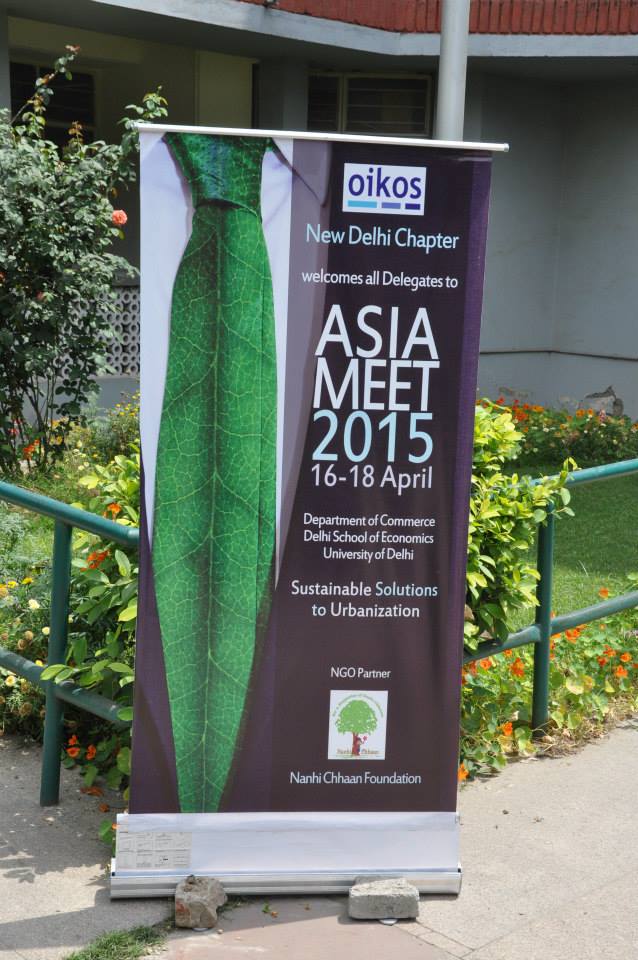
On day one, the oikos Asia Meet 2015 was envisaged as a platform for young change-makers to contemplate deliberate and express individual views on the rather multi-faceted topic of “Urbanization and Sustainability”. After inaugural addresses by Raisa Adhikari and Malvika Garg, the President and Vice- President, respectively of oikos New Delhi, oikos International President, Anita Negri shared her personal experiences and offered examples of successful initiatives on sustainable urbanization undertaken in Europe. She also took the opportunity to appreciate the efforts by Indian PM, Mr. Narendra Modi to create 100 smart cities in India, within 2022. The activities kicked off with an exciting ice breaking session coordinated by Ankit Agarwal which gave all the participants a forum to interact and get to know one another.
The first session of the meet was by Mr. Harpal Singh, Founder and Chairman of the Nanhi Chann Foundation, a Non-Governmental Organization that amalgamates two of the most alarming concerns in India, forest conservation and gender inequality. Mr. Singh emphasized the fundamental principle of growth through sustainability, which governs the initiatives of Nanhi Chaann, literally meaning “gentle shade”. The abysmally low gender ratio in India causes a disturbance of natural order which in-turn can lead to a cascading effect on society including the family structure, culture and socio-economic scenario. A rather remarkable fact that he brought out was that gender ratio is the only social indicator that has an adverse co-relation with development and socio-economic factors, i.e. some of the most sophisticated and educated families have among the lowest gender ratio. He urged the urban youth to show deep concern about the status and well-being of young women. He highlighted the concept of planting a sapling when a new girl comes into the household either by birth or by marriage since both girls and trees exemplify the essence of motherhood- essentially givers and not takers. Sustainability is harmonizing competing interests in the optimal manner. Harmony between society, economics and technology is the need of the hour. The role of youth is not only to excite themselves but to inspire others, likewise.
The second session was a panel discussion moderated by Mr. Kedarnath Ghorpade, Mr. Shelley Viswajeet and Ms. Anita Negri. The open floor for the participants brought out some interesting and thought provoking discussions on how they perceived Delhi vis-à-vis other cities they have been to. Many a times lying behind the glossy exterior is dilapidated core infrastructure in many modern day cities. Delhi is certainly a city of opposites, a city where the billionaires live side by side with the impoverished. Though India’s problems are multi-fold because of the burgeoning population issue, Anita rightly points out that the anomaly of the great divide is not just in India, it is happening in countries across the globe.
 Post a sumptuous lunch, Mr. Kedarnath Ghorpade, a prominent urban planner, took a very insightful session on the future of eco-cities. From the wealth of experience he had accumulated over the years, he cited that urban planners have the challenge of accommodating all the mutually conflicting requirements of the inhabitants. He went on to discuss the various perspectives of standard urban challenges including water supply, sewage and sanitation, solid waste management and urban transport services. He delineated the criteria and guidelines to assess eco-cities through eco-measurability and discussed the advantages of a compact smart city over a spread out city in terms of optimizing infrastructure usage.
Post a sumptuous lunch, Mr. Kedarnath Ghorpade, a prominent urban planner, took a very insightful session on the future of eco-cities. From the wealth of experience he had accumulated over the years, he cited that urban planners have the challenge of accommodating all the mutually conflicting requirements of the inhabitants. He went on to discuss the various perspectives of standard urban challenges including water supply, sewage and sanitation, solid waste management and urban transport services. He delineated the criteria and guidelines to assess eco-cities through eco-measurability and discussed the advantages of a compact smart city over a spread out city in terms of optimizing infrastructure usage.
The first session of the second day was taken by Mr. Shelly Viswajeet, Founder of the Earthcare Foundation. The session mainly delved into what ‘smart cities’ actually means, the various features and the issues they strive to address and what it will take to make environmentally sustainable smart cities the future. The discussion then took a turn to overwhelm the audience by presenting a rather scary, apocalyptic scenario that mankind stares at in the face of urbanization. The speaker then drew analogies between the extinction of the passenger pigeon and the Indian panthers. The very pertinent issue of co-existence and co-habitation was discussed much fervently. The speaker then touched upon the fabulous opportunities that urbanization provides including the concentrated attack on poverty, more efficient utilization of resources, greater avenues for learning, education and creativity. The state’s power in policy implementation influences the entire spectrum of urbanization and the growth of the urban society.
The second session of the day, focusing on policy advocacy and campaigning for change, was steered by Mr. Avi Mukesh, a Greenpeace activist who has worked with Centre for Science and Environment (CSE), one of the most respected not-for-profit societies working in the field of environmental sustainability. He elucidated the theory of change as a tool for developing solutions to complex social problems. He propounded the idea of identifying a long term goal and pre-conditions for achievement of those goals through backward mapping. He subtly pointed to the fact that advocacy and lobbying are dependent on the ability of activists to create a narrative to create awareness and generate a positive response from all the relevant stakeholders. He went on to provide a practical perspective through examples of Greenpeace campaigns on air pollution and the feasibility of roof-top solar power panels in Delhi. The success of campaigns depends not only on education but more so on the motivation and personal conviction of the activists. Some probing questions were asked about whether certain issues like climate change are too broad and can’t be campaigned against. The strategies may differ but campaigning is not limited in its scope.
The third and final session of the day was piloted by Dr. Amit Sengupta, an anthropologist and Associate Professor with the Department of English Journalism at Indian Institute of Mass Communication. He discussed the dynamics of land acquisition and the resistance by local community especially tribals, drawing an analogy with James Cameron’s Avatar. He put forth the view that modernity deprived of the principles of participative democracy and equality is never sustainable. He brought out a very pertinent view that searching for solutions gives us a catharsis. Hence, we tend to be way more interested in looking for solutions without properly analyzing the problems holistically.
 The curtains on the sessions were drawn with a short carbon foot-printing activity that gave all participants an opportunity to introspect and calculate their carbon footprints. Hands on activities were then initiated such as the planting of saplings and picture takings. Participants then were taken to visit the Rashtrapati Bhawav, the residence of the Indian President and the landmark India Gate. The conference closed with a private party and a thanksgiving ceremony in which participants were given organic teas and soaps by the organizing team. The meet was a resounding success and set a new benchmark for future meets.
The curtains on the sessions were drawn with a short carbon foot-printing activity that gave all participants an opportunity to introspect and calculate their carbon footprints. Hands on activities were then initiated such as the planting of saplings and picture takings. Participants then were taken to visit the Rashtrapati Bhawav, the residence of the Indian President and the landmark India Gate. The conference closed with a private party and a thanksgiving ceremony in which participants were given organic teas and soaps by the organizing team. The meet was a resounding success and set a new benchmark for future meets.
Article written by Saurav Kumar Das.
Pictures by Vikas Bhardwaj. More photos here.





